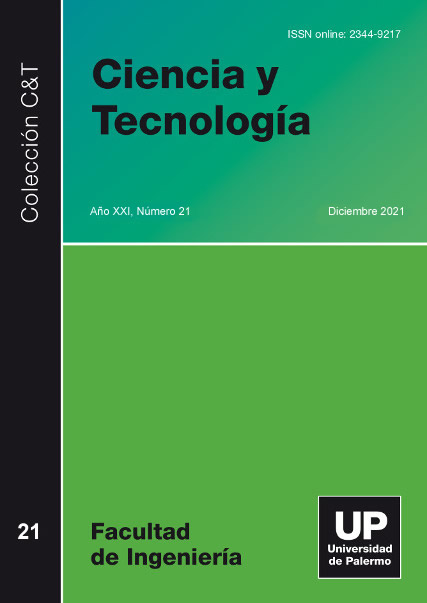Diseño de una herramienta para la clasificación de imágenes de cáncer de piel utilizando Redes Neuronales Profundas (DNN)
Resumen
El cáncer de piel es una de las enfermedades más comunes en la población mundial. Habitualmente, el diagnóstico requiere la adquisición de imágenes dermatoscópicas. Tanto la biopsia como la histopatología se han utilizado en estadios avanzados. Su detección precoz es muy importante para aumentar la calidad y la esperanza de vida del paciente. En Colombia, la falta de profesionales calificados e instrumental médico dificulta esta tarea. La clasificación automática es un gran desafío, debido a la amplia variedad y morfología de las lesiones cutáneas. Hoy en día, Deep Learning alcanza niveles elevados de precisión en las tareas de clasificación de imágenes y está destinado a convertirse en una solución confiable para la clasificación de imágenes médicas. En esta investigación, utilizó estas ventajas de DNN para construir una red neuronal convolucional (CNN) entrenada con bases de datos de código abierto para la clasificación de lesiones cutáneas benignas y malignas. Después del proceso de entrenamiento, desarrollamos un sistema embebido con raspberry Pi 3 B + con una cámara genérica e implementamos la CNN descrita en Python basada en codificación. Para la clasificación benigna y maligna, el prototipo alcanzó un nivel de precisión del 91,06% en la puntuación F1 y una sensibilidad del 91,98%.
Descargas
Citas
Castillo, J. A., Granados, Y. C., & Fajardo, C. A. (2020). Patient-specific detection of atrial fibrillation in segments of ecg signals using deep neural networks. Ciencia E Ingenieria Neogranadina, vol. 30, no. 1, 45–58.
Chanampe, H., Aciar, S., Vega, M. d., Molinari Sotomayor, J. L., Carrascosa, G., & Lorefice, A. (2019). Modelo de redes neuronales convolucionales profundas para la clasificacion de lesiones en ecograf´ ´ıas mamarias. in XXI Workshop de Investigadores en Ciencias de la Computacion (WICC´ 2019, Universidad Nacional de San Juan).
Chicco, D. J. (2020). The advantages of the matthews correlation coefficient (mcc) over f1 score and accuracy in binary classification evaluation. BMC genomics, vol. 21, no. 1, 6.
Diana, H. (2021). Tesisredes-dianahellis-2021/skincancerclassifier. Obtenido de https://github.com/TesisRedes-DianaHellis-2021?tab=repositorie
Gamerosa, P. C., & Tellez, J. E. (2016). El cancer de piel, un problema actual. Revista de la Facultad de Medicina UNAM, vol. 59, no. 2, 6–14.
Glorot, X., & Bengio, Y. (2010). Understanding the difficulty of training deep feedforward neural networks. Proceedings of the thirteenth international conference on artificial intelligence and statistics, 249–256.
Instituto de Hidrología, Meteorología y Estudios Ambientales. (2014). “Indice ultravioleta (iuv) - ideam. Obtenido de http://www.ideam.gov.co/web/tiempo-y-clima/indice-ultravioleta-iuv-
Kaggle. (s.f.). Skin Cancer ISIC. Obtenido de https://www.kaggle.com/nodoubttome/skin-cancer9-classesisic
Mao, H. H. (2020). A survey on self-supervised pre-training for sequential transfer learning in neural networks. arXiv preprint arXiv:2007.00800.
Mikołajczyk, A., & Grochowski, M. (2018). Data augmentation for improving deep learning in image classification problem. 2018 international interdisciplinary PhD workshop (IIPhDW). IEEE, 117–122.
Morocho Jiménez, J. I. (2019). Detección de tumores cutáneos malignos y benignos usando una red neuronal convolucional. Quito: B.S. thesis.
Ng, A., Besounda Mourris, Y., & Karantoforoosh, K. (2021). Deep learning. Obtenido de https://www.coursera.org/specializations/deep-learning
Pérez Lorenzo, C., & et al. (2019). Detección precoz de cáncer de piel en imágenes basado en redes convolucionales,. B.S. thesis.
Powers, D. M. (2010). Evaluation: from precesion, recall and f-measure to roc, informedness, makedness and correlation. arXiv preprint a arxiv, 16061.
Qin, Z., Yu, F., Liu, C., & Chen, X. (2018). How convolutional neural network see the world-a survey of convolutional neural network visualization methods. arXiv preprint arXiv:1804.11191.
Sanjay, M. (2018). Why and how to Cross Validate a Model? Obtenido de https://towardsdatascience.com/why-and-how-to-cross-validate-a-model-d6424b45261f
Shin, H.-C., Roth, H. R., Gao, M., Lu, L., Xu, Z., Nogues, I., . . . Summers, R. M. (2016). Deep convolutional neural networks for computer-aided detection: Cnn architectures, dataset characteristics and transfer learning. IEEE transactions on medical imaging, vol. 35, no. 5, 1285–1298.
Shorten, C., & Khoshgoftaar, T. M. (2019). A survey on image data augmentation for deep learning. Journal of Big Data, vol. 6, no. 1,, 60.
Sokolova, M., Japkowicz, N., & Szpakowicz, S. (2006). Beyond accuracy, f-score and roc: a family of discriminant measures for performance evaluation. Australasian joint conference on artificial intelligence. Springer, 1015–1021.
Static Raspberrypi. (s.f.). Raspberry pi modelbplus product brief. Obtenido de https://static.raspberrypi.org/files/product-briefs/raspberry-pi-modelbplus-product-brief.pdf
Team, K. (s.f.). Keras documentation: Keras applications. Obtenido de https://keras.io/api/applications
Tschandl, P. (2018). The HAM10000 dataset, a large collection of multi-source dermatoscopic images of common pigmented skin lesions. Obtenido de https://doi.org/10.7910/DVN/DBW86T
Xia, B., Zhang, H., & Li, Q. L. (2015). Pets: A stable and accurate redictor of protein-protein interacting sites based on xtremely-randomized ree. IEEE Transactions on NanoBioscience, vol. 14, 1–1, 11 .
Los artículos publicados en la Revista Ciencia y Tecnología son de exclusiva propiedad de sus autores. Las opiniones y el contenido de los mismos pertenecen a sus autores, declinando la Universidad de Palermo toda responsabilidad por los derechos que pudiera derivarse de la lectura y/o interpretación del contenido de los artículos publicados.
No se autoriza la reproducción, utilización ni explotación por parte de ningún tercero de los artículos publicados. Sólo se autoriza su uso para fines exclusivamente académicos y/o de investigación.









